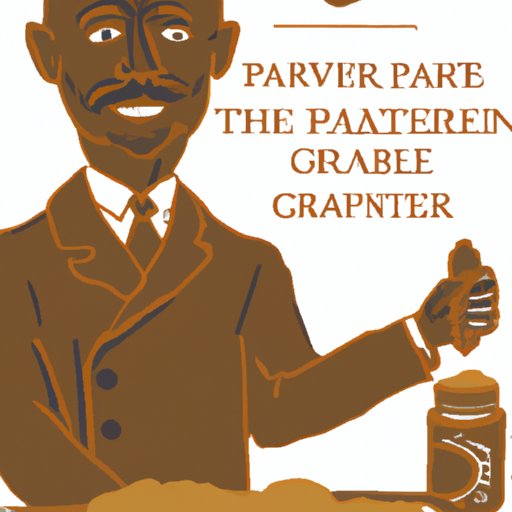Introduction
The name George Washington Carver is often associated with the invention of peanut butter. However, this claim is nothing more than a myth. While Carver was an accomplished scientist and inventor, he did not actually invent peanut butter. Despite this, Carver’s work with peanuts changed the food industry for the better and had a lasting impact on the peanut butter industry. In this article, we will explore the history of peanut butter, George Washington Carver’s role in its development, and the legacy he left behind.
Examining the History of Peanut Butter and George Washington Carver’s Role in Its Development
Peanut butter has been around since the late 1800s, long before George Washington Carver ever stepped foot in a laboratory. According to food historian John Mariani, “the earliest known reference to peanut butter appeared in the U.S. patent office in 1884.” The patent was awarded to Marcellus Gilmore Edson of Montreal, Canada. Edson’s process involved boiling peanuts until they became soft enough to be ground into a paste.
Despite this, many people still believe that George Washington Carver invented peanut butter. This misconception likely comes from Carver’s groundbreaking work with peanuts. Carver was born into slavery in Missouri in the 1860s and went on to become one of the most influential scientists of the 20th century. During his career, he developed hundreds of products from peanuts, including dyes, plastics, paints, cosmetics, and even gasoline.
Carver was also a major proponent of crop rotation. He encouraged farmers to rotate their crops in order to prevent soil erosion and improve the fertility of their land. He believed that by rotating their crops, farmers could produce more food and make a larger profit. As a result, farmers began to plant more peanuts, which led to an increase in peanut production.
While Carver did not invent peanut butter, his work with peanuts helped to popularize it. According to food historian Ken Albala, “Carver’s efforts to encourage the cultivation of peanuts and to promote them as a valuable crop were key in making peanut butter an affordable and popular foodstuff.”
A Look at the Impact of George Washington Carver on Peanut Butter Production
Before George Washington Carver, peanut butter was a relatively expensive and uncommon food item. It was mostly used as a novelty item or as a health food. However, after Carver’s work with peanuts, the price of peanut butter dropped significantly and it became more widely available.
Carver also helped to make peanut butter more palatable. Prior to his work, peanut butter was made from raw peanuts, which had an unpleasant flavor. Carver developed a process for roasting peanuts, which improved the flavor of the peanut butter. He also experimented with adding sugar and other ingredients to enhance the taste of the peanut butter.
In addition, Carver’s research helped to revolutionize the peanut butter industry. His work with peanuts inspired the development of new processing techniques and machinery, which allowed for faster and more efficient production. This made it possible for companies to mass-produce peanut butter and sell it at a lower cost.
Conclusion
George Washington Carver did not invent peanut butter, but his work with peanuts had a profound impact on the food industry. Through his research and experimentation, Carver helped to make peanut butter more affordable and accessible. He also improved the flavor of peanut butter and revolutionized the peanut butter industry through the development of new processing techniques and machinery. His legacy lives on in the modern peanut butter industry, and his accomplishments are an inspiration to us all.
(Note: Is this article not meeting your expectations? Do you have knowledge or insights to share? Unlock new opportunities and expand your reach by joining our authors team. Click Registration to join us and share your expertise with our readers.)
